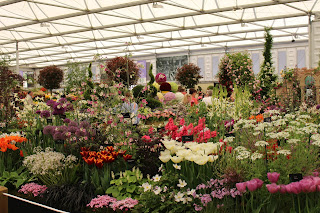Tulip time
“Kosovo battlefield was strewn with heads and turbans, similar to a bed of tulips”, is what a Turkish chronicler wrote about the battle between the Serbs and Ottomans in the year 1389. The comparison to tulips and turbans is an ancient one, and this is where we westerners get the name for this lovely flower. A gentler story is that fashionable noblemen in Istanbul were wearing tulips on their turban and when a westerner asked about the flower, the translator may have confused the name for the headdress with the flower. In Turkish, they are called ‘lale’, which in Arab character is spelled with the same letters as ‘allah’, and thus tulips became the symbol for god and all he represents. Tulips became the representation of paradise on earth. Later the House of Osman took the tulip as their symbol, as the divine rulers of the empire, and this resulted in synonymy of tulips with Turkey. Sure, there are native tulips in Turkey, but the fashion for growing tulips and the complex hybrids now grown originate further East, probably in modern-day Iran or Uzbekistan. Several species were probably dug up from the wild some 1000 years ago and planted in early Persian gardens, where they crossed and produced larger flowered, more vigorous hybrids. These were then spread along the silk route westwards. During Ottoman times the sultans ordered tulips from the far corners of their empire to be planted in the palatial gardens and parks of Istanbul and thus they became more diverse, giving the Ottoman horticulturalists lots of material to breed with. This resulted in flower shows, tulip pageant and awards for the best type. Prices for rare tulips rose quickly, until the sultan interfered. When some 80 years later tulips reached western Europe through diplomatic means, they soon became popular garden plants. In Europe, they became the symbol of resurrection and as such became a valuable commodity. Varieties with round rather than pointy petals became popular, and the masters of still-life oil painting popularised the striped ones, which were sold for large sums of money. This led eventually to tulip-mania, first in France and then the Netherlands, where people speculated with rare tulip bulbs and large sums of cash. Unfortunately, many of the highly priced striped types were infected with tulip mosaic virus, and would produce the fabulous striped blooms only once, after which the bulb dies, no good for breeding and thus a bad investment. Lots of people lost their money this way.
The financial markets have unfortunately not
learned from this lesson, and nor have politicians, even though this is a
classic example in their economy text books. Maybe politicians see it as a way
to get more money off the public, gambling is addictive. I wish economics was like
a tulip bulb though, if you treat them well and manage to keep the squirrels
from stealing them, you get more each year. The more you have, the better. Just
in case I plant loads each year: tulips are a humble luxury.




Comments
Post a Comment